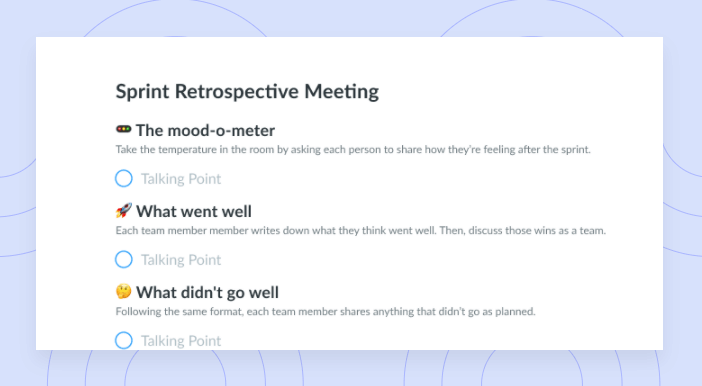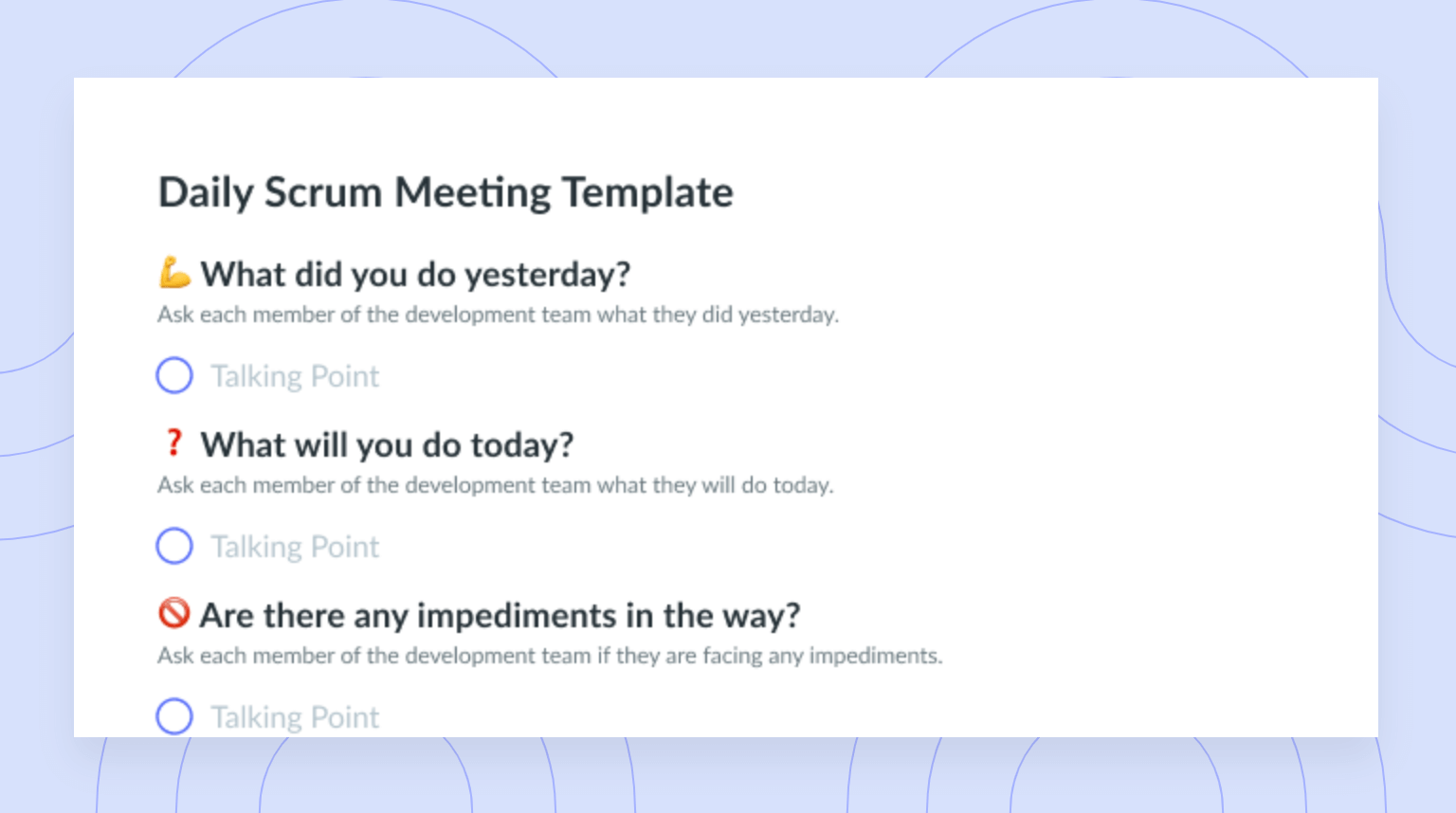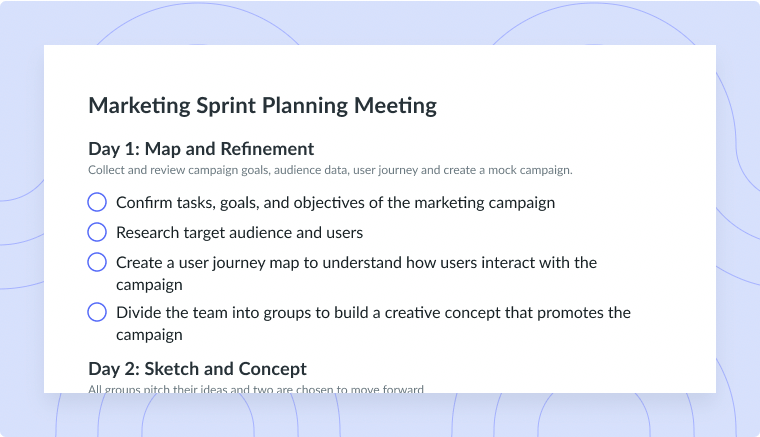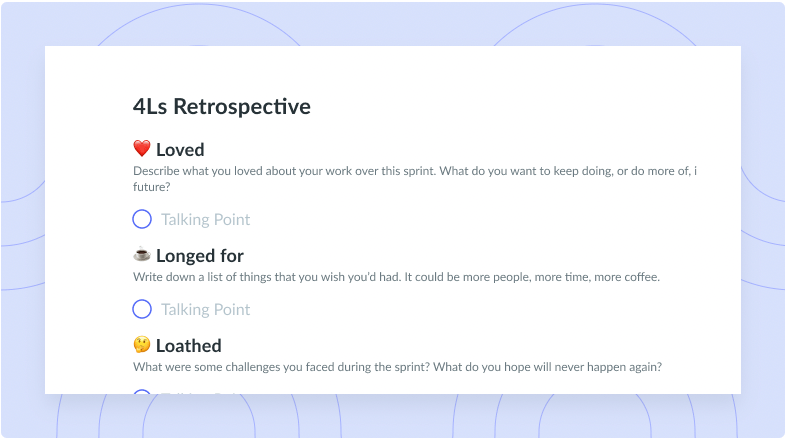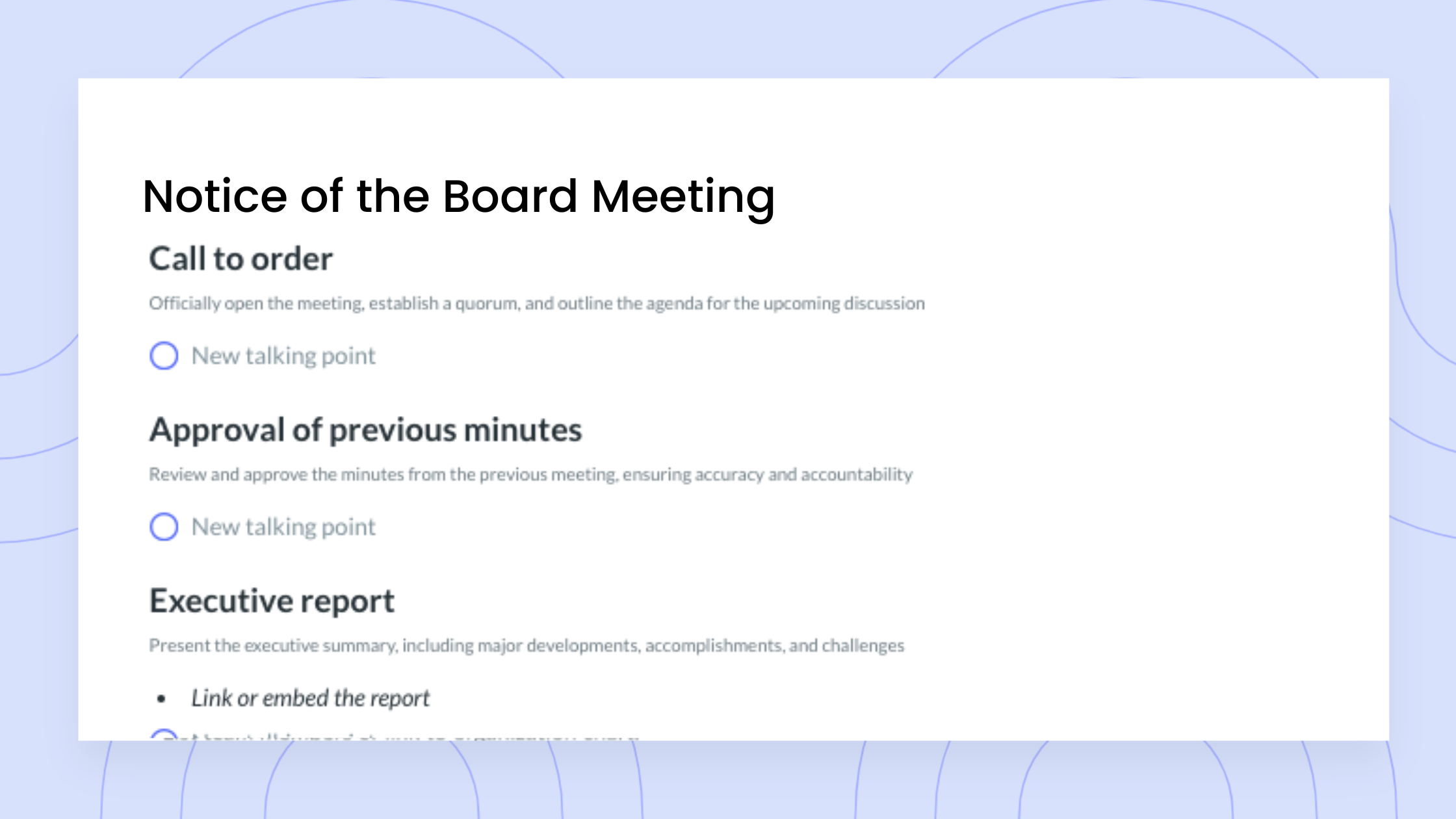Sprint Review Meetings: Tips (+Template) for Better Sprint Reviews
Learn how to achieve productive and efficient Sprint Review Meetings by following our tips and template!
According to Harvard Business Review, Sprint Reviews increase team productivity and employee satisfaction all while minimizing “redundant meetings, repetitive planning, excessive documentation, quality defects, and low-value product features.”
But, to achieve these benefits you need to know how to run a Sprint Review meeting! Follow along as we demonstrate exactly how to run a Sprint Review meeting for more efficient Sprint Reviews…
- What is a Sprint Review meeting?
- What do you do in a Sprint Review?
- How long is a Sprint Review meeting?
- How to facilitate a sprint review meeting
- Sprint Review Meeting Template
- Sprint Review vs. Sprint Retrospective
What is a Sprint Review meeting?
A Sprint Review is a meeting where the development team, the scrum master, the product owner, and the stakeholders give demos on new products created during the Sprint to determine which products are finished and which aren’t.
Sprint Review meetings are important because they allow the development team to showcase what they developed during the Sprint. These meetings are also generally informal, avoiding PowerPoints and scripts.

Pro tip
Use a meeting management tool like Fellow to have a collaborative meeting agenda for your sprint review meetings.
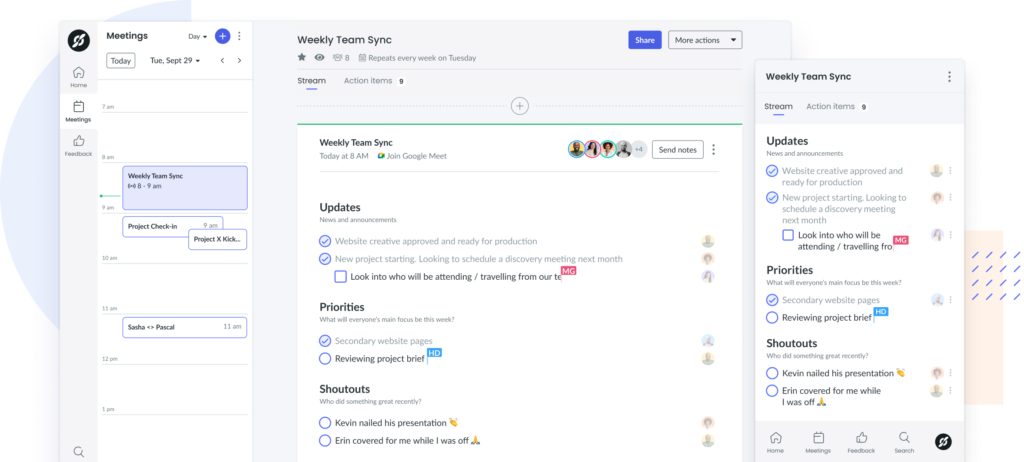
What do you do in a Sprint Review?
In Sprint Review meetings teams demo new products that they built during the Sprint. During the demos, team members will inspect the product and give feedback on how to improve it.
Each Sprint will produce a lot of valuable products and help your team get better for the next Sprint. Learning from experience is the best way to grow! So, take this opportunity to be proud of what you have produced and showcase it to your team members.
“Your team will accomplish a ton in every sprint, but the knock-on effects — the confidence of knowing you’re on the right road — are even more powerful.”
– John Zeratsky, Harvard Business Review Contributor.
How long is a Sprint Review meeting?
Nobody likes long meetings, no matter how interesting they are! Sprint Review meetings should follow this same principle, maxing out at four hours. Now, four hours is LONG, so don’t feel like you need to fill time.
A good practice to follow is to allot time on a meeting agenda to everything that needs to be covered (for example, introduction, demo, feedback, etc.) to avoid painfully long meetings. At the same time, be cautious not to rush your team members while they are showcasing their hard work.
It is typically the Scrum Master’s responsibility to run the meeting, therefore they are responsible for watching the time or allotting a timekeeper.
How to facilitate a sprint review meeting [agenda]
So, now that you know what a Sprint Review meeting is, who to invite, and how long it will take, it’s time to learn how to facilitate it…
As you could probably guess, you’re going to need to use a meeting agenda template! Your meeting agenda should include the following things:
1 Sprint goals
Before the Sprint, your team should have a Sprint Planning meeting where you will set Sprint Goals. These are goals that your team wants to achieve in the upcoming Sprint.
So, during your Sprint Review meeting, it is a good idea to remind everyone of the Sprint Goals to inspect the outcome of the Sprint. This will also help keep teams accountable for achieving set goals.
2 Completed tasks
As with any meeting agenda, it is always good to include completed tasks. This will help your team get an idea of the progress that has been made.
In a Sprint Review meeting, this time is an opportunity to tell your team what action items were completed during the Sprint and what was put on the back burner for the next Sprint.
3 Demos
The demos portion of the meeting is the most exciting part – the show and tell! During the demo, the product owner presents their product in an informal way showcasing what they did during the Sprint.
4 Stakeholder feedback
After the demos, the stakeholders will give their feedback on the product. Although their feedback is important, it is also important that feedback is not delivered in a judgmental way. This can be enforced by asking stakeholders for feedback actively during the demo. Or, if you don’t want to be interrupted, ask the stakeholders to write down questions as comments on the agenda as they come up so that you can address them when you’re finished.
It is also important to learn how to take constructive feedback and use it, well, constructively! Here are a few tips:
- Keep an open mind
- Remember that they’re trying to help
- Record the feedback in meeting notes or meeting minutes
- Ask questions if you need clarification
5 Key metrics
The key metrics are an opportunity to assess if scrum teams met certain goals. It is also a way to evaluate how the scrum team performed during the Sprint.
Both team effectiveness and product effectiveness should be measured, taking into account each attendee’s points – for example, the Scrum Masters, the stakeholders, and the development teams.
6 Backlog
A backlog is a list of everything that needs to be done before the product is given the go-ahead. This includes things like features, bugs, and adaptations.
Unlike a traditional to-do list where action items are completed and then forgotten about, backlogs will never go away! What I mean by that is your product will continuously need updates and added features, so although you may complete what is on the backlog, something new will almost always be added.
Sprint Review Meeting Template
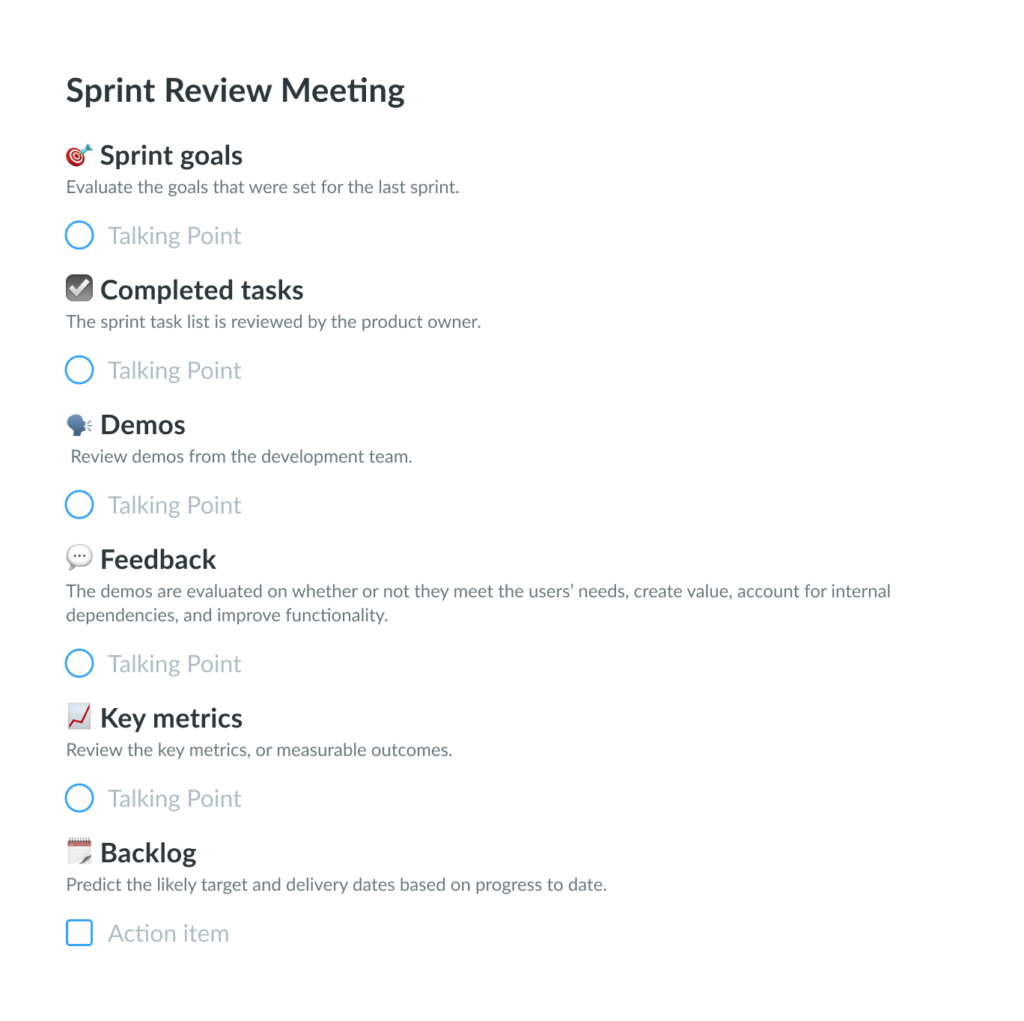
Sprint Review vs. Sprint Retrospective (what’s the difference?)
During the Sprint Review, team members will showcase what products they produced during the Sprint. However, during the Sprint Retrospective, attendees focus on the processes of the product. The Sprint Retrospective should also be held right after the Sprint Review.
Here are a few key differences between the Sprint Review and the Sprint Retrospective:
| Sprint Review | Sprint Retrospective |
| Shorter | Longer |
| Showcases product | Evaluates processes of the product |
| Informal | More formal |
Parting advice
Following the above advice and Fellow’s amazing Agile Meeting templates, you are now ready… So, grab your dev team, the scrum master, the product owner, and the stakeholders and begin running better Sprint Reviews!
“The highest priority is to satisfy the customer through early and continuous delivery of valuable software.”
– Lee Davis, Forbes Contributor.

![How to Run an Effective Sprint Planning Meeting [+ Free Template]](https://fellow.app/wp-content/uploads/2022/03/sprint-meeting.jpg)



![Sprint Planning Meeting Guide [+ Free Template]](https://fellow.app/wp-content/uploads/2020/12/Sprint-Planning-Team.jpg)




